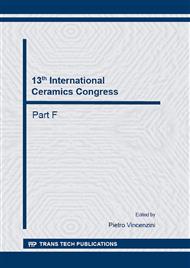p.14
p.20
p.26
p.32
p.38
p.44
p.50
p.56
p.62
Studies of Natural and Accelerated Carbonation in Metakaolin-Based Geopolymer
Abstract:
The carbonation of Portland-cement-based materials involves the reaction between atmospheric CO2 and calcium ions in the pore solution. The formation of calcium carbonate is responsible for a decrease in the pH of the pore solution from 12.5 to 9, thus leading to the depassivation of steel reinforcements and their possible corrosion, and can also lead to efflorescence (white crystals formed on the surface). In metakaolin-based geopolymer activated by sodium silicate, in which calcium is almost non-existent, the presence of CO2 will lead to the formation of sodium carbonates. Since geopolymer can be carbonated, the risk of corrosion or efflorescence needs to be assessed. A pH study of the geopolymer pore solution showed a very fast decrease compared to OPC, with almost total carbonation after only 14 days. In natural atmospheric CO2 conditions, it was found that the formation of sodium carbonate did not lead to a decrease of the pH to below a value around 9, thus limiting the risk of corrosion by depassivation of reinforcement, but the large amount of carbonate suggested a significant risk of efflorescence. A study of accelerated carbonation performed under an atmosphere of 50% CO2 highlighted the formation of sodium bicarbonate resulting in a lower pH of the pore solution and a much larger amount of product formed. Finally the study of efflorescence carried out by semi-immersion tests in natural or accelerated conditions confirmed the different nature of the crystals formed (sodium carbonate or bicarbonate) but showed no significant impact on the amount of carbonated products. This study thus demonstrates that the accelerated carbonation test had very limited usefulness, given the rapidity of the natural reaction. Furthermore, it was found that this test did not reproduce reality as it led to different reaction products.
Info:
Periodical:
Pages:
38-43
Citation:
Online since:
October 2014
Authors:
Keywords:
Price:
Сopyright:
© 2014 Trans Tech Publications Ltd. All Rights Reserved
Share:
Citation:


